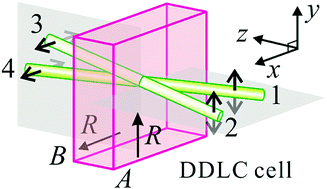Optically controllable photonic crystals and passively tunable terahertz metamaterials using dye-doped liquid crystal cells
Abstract
This work fabricates a fishnet grating by exerting two one-dimensional (1D) holographic interference fields with mutually orthogonal grating vectors separately on the substrates of a dye-doped liquid crystal (DDLC) cell. The DDLC mixture in the cell includes a nematic LC, methyl red (MR) dye, and 4-methoxyazobenzene (4MAB) dye. The fishnet grating is formed because the periodical adsorption of the MR dye on the irradiated surfaces of the cell causes the anisotropic photoalignment of the LC. The fishnet grating can be erased (recovered) by the illumination of a UV (green) beam since the trans → cis (cis → trans) isomerization of the 4MAB dye causes the isothermal nematic → isotropic (isotropic → nematic) phase transition of the LC. Such a grating can be used to develop optically controllable photonic crystals. Simulated results depict that a photoresist-coated plastic substrate that is exposed to the fishnet pattern of a 2D grating can be used to develop terahertz fishnet metamaterials, and their resonance spectra can be passively tuned by moving the substrate and lens that forms the fishnet pattern during fabrication. Therefore, the mask-free photolithography can be used to fabricate passively tunable terahertz filters.



 Please wait while we load your content...
Please wait while we load your content...